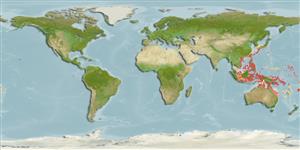>
Gobiiformes (Gobies) >
Gobiidae (Gobies) > Gobiinae
Etymology: Eviota: No etymology given, suggested by Christopher Scharpt: from Latin 'eu' for 'true' and 'iota' for anything very small, in combination 'truly very small' referring to it as being the smallest vertebrate at the time it has benn described by Jenkins (thus, making the suggestion by Scharpt plausible.; shimadai: Named for Kazuhiko Shimada; noun in genitive case..
More on authors: Greenfield & Randall.
Environment: milieu / climate zone / depth range / distribution range
Οικολογία
Θαλασσινό(ά) Υφαλόφιλο(α); εύρος βάθους 0 - 29 m (Ref. 83982). Subtropical
Western Pacific: Japan, Philippines, Palau and Indonesia.
Μέγεθος / Βάρος / Age
Maturity: Lm ? range ? - ? cm
Max length : 1.6 cm SL αρσενικό/απροσδιόριστο; (Ref. 83982); 1.5 cm SL (female)
Short description
Μορφολογία | Μορφομετρία
Ραχιαίες άκανθες (συνολικά): 7; Μαλακές ραχιαίες ακτίνες (συνολικά): 8-9; Εδρικές άκανθες 1; Μαλακές εδρικές ακτίνες: 7 - 8. This species is distinguished from its congeners by the following set of characters: dorsal/anal fin-ray formula usually 8/8, sometimes 8/7 or 9/8; pectoral fin rays 16-17 (usually 16), all unbranched; cephalic sensory-pore system pattern IV (lacking pores PITO and IT, AITO enlarged, engulfing the PITO); fifth segmented pelvic-fin ray variable, absent to 18% of fourth ray; non-fimbriate genital papilla; filamentous first dorsal fin (second spine 67.2% SL in holotype); branches on fourth pelvic-fin ray 2-3, 2-3 segments between branches; body with no distinct large dark marks; side of body with scattered internal melanophores, under pectoral fin and on side of head; presence of silver bar across central part of pectoral-fin base when alive (Ref. 83982); characterized further by semi translucent body with irregular, internal reddish midlateral stripe; presence of rows of small reddish spots along dorsal midline; usually with several narrow reddish bars above base of anal fin; longitudinal scale series 23-24; sctenoid scales, absent on head, nape and base of pectoral fin; depth of body 4.3-5.0 in SL (Ref. 90102).
Inhabits sheltered reefs in 3-20 (Ref 90102).
Life cycle and mating behavior
Γεννητική Ωρίμανση | Αναπαραγωγή | Γεννοβολία | Αβγά | Γονιμότητα | Προνύμφες
Greenfield, D.W. and J.E. Randall, 2010. Four new gobiid fishes of the genus Eviota from the Western Pacific, with clarification of Evoita guttata and Evoita albolineata (Teleostei: Goblidae). Proc. Calif Acad. Sci. 61(3):269-289. (Ref. 83982)
IUCN Red List Status (Ref. 130435)
Threat to humans
Harmless
Human uses
Περισσότερες πληροφορίες
Κοινά ονόματαΣυνώνυμαΜεταβολισμόςΘηρευτέςΟικοτοξικολογίαΑναπαραγωγήΓεννητική ΩρίμανσηΓεννοβολίαΣυναθροίσεις γεννοβολίαςΓονιμότηταΑβγάEgg development
Age/SizeΑύξησηLength-weightLength-lengthLength-frequenciesΜορφομετρίαΜορφολογίαΠρονύμφεςΔυναμική προνυμφώνΣτρατολόγησηΑφθονίαBRUVS
ΑναφορέςΥδατοκαλλιέργειεςΠροφίλ υδατοκαλλιέργειαςΣτελέχοιΓενετικήElectrophoresesΚληρονομικότηταΑσθένειεςΜεταποίησηNutrientsMass conversion
ΣυνεργάτεςΦωτογραφίεςStamps, Coins Misc.ΉχοιΣιγκουατέραΤαχύτηταΚολυμβητικός ΤύποςΕπιφάνεια βραγχίωνOtolithsΕγκέφαλοιΌραση
Εργαλεία
Special reports
Download XML
Διαδικτυακές πηγές
Estimates based on models
Preferred temperature (Ref.
123201): 25.1 - 29.3, mean 28.7 °C (based on 973 cells).
Phylogenetic diversity index (Ref.
82804): PD
50 = 0.5000 [Uniqueness, from 0.5 = low to 2.0 = high].
Bayesian length-weight: a=0.01023 (0.00477 - 0.02194), b=3.02 (2.84 - 3.20), in cm total length, based on LWR estimates for this (Sub)family-body shape (Ref.
93245).
Τροφικό Επίπεδο (Ref.
69278): 3.0 ±0.3 se; based on size and trophs of closest relatives
Ελαστικότητα (Ref.
120179): Υψηλό, ελάχιστος χρόνος για διπλασιασμό πληθυσμού < 15 μήνες (Preliminary K or Fecundity.).
Fishing Vulnerability (Ref.
59153): Low vulnerability (10 of 100).
